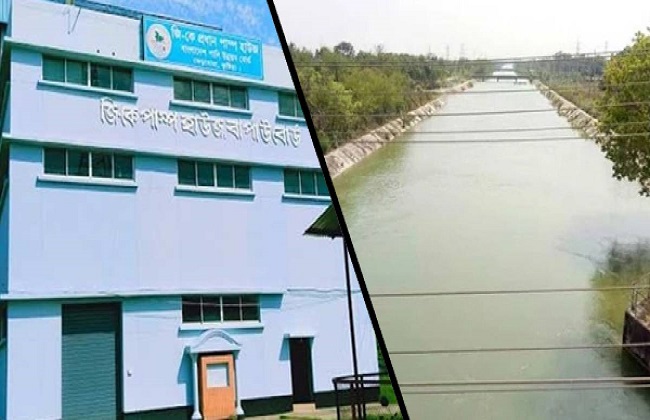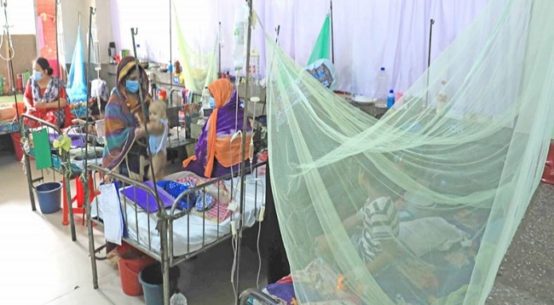
Irrigation is critical for crop production in Bangladesh and the heart of most irrigation systems are pumps.
There are 15 pumps – three main devices and 12 subsidiaries – in the Ganges-Kobadak Irrigation Project or GK Project – a large surface irrigation system set up by the Bangladesh Water Development Board (BWDB) on the right bank of the River Ganges – the River Padma in Bangladesh.
The pumps – with a total lifting capacity of 153 cumec – are used to draw water from the Padma through an intake channel to supply it to the fields by gravity canals.
GK, the first major step in Bangladesh to provide supplemental irrigation to traditional rice varieties, covers an area of 197,500 hectares in Kushtia, Chuadanga, Jhenaidaha and Magura districts.
Thirteen upazilas – Kushtia Sadar, Kumarkhali, Khoksa, Mirpur, Bheramara, Chuadanga, Alamdanga, Jhenaidaha, Harinakunda, Shailkupa, Magura Sadar, Sreepur and Daulatpur – are served by the project in two seasons.
However, the project, the largest lift-cum-gravity irrigation system in the country, largely missed its targets – raising food production, cropping intensity; improving cropping patterns and the socio-economic conditions of the farmers.
It is facing multiple setbacks both at the implementation and operational stages like other irrigation projects in Bangladesh.
Hundreds of farmers in four districts of the Khulna division have been deprived of irrigation facilities from the project for years. GK is now in the grip of land grabbers, mismanagement, and negligence.
The area of the project is shrinking day by day as land sharks continue to fill up the irrigation canals. Now only 116,000 hectares of land of GK is net irrigable.
Also, as there is no proper drainage system, most of the water supplied from the project is wasted. The system needs to be improved to prevent waterlogging of low lands as well.
The network of canals is not capable enough to distribute water to the entire irrigable area; bank erosion and siltation have markedly reduced their water carrying capacity.
Also, because of the poor canal systems, the pumps are now being used at around 50 per cent of their capacity.
As the canals are not dredged at the right time, it becomes difficult for water to reach land or crops to help growth.
The old system needs to be rehabilitated and new canals need to be set up to increase irrigation coverage by completely using the potential pumping capacity of the project.
Also, demand for irrigation water has been considerably higher than expected. Extracting water from the Padma, the main source of water for the GK Project, becomes difficult in the dry season as the pumps were designed much below the water level.
One usually has no choice about the source of the water. However, to make an irrigation system as efficient as possible, the pumps must match the requirements of the water source, distribution system and irrigation equipment.
Since farmers of 13 upazilas had been getting diminishing irrigation facilities from GK, many of them started using deep tube wells and pumps to irrigate lands. However, they also used surface water whenever it was available.
Meanwhile, the number three main pump of GK, set up in 2005, went out of order on April 19, 2016.
Thousands of farmers, from four districts, depend on water from GK to produce paddy and other crops. As one of the main pumps was not in operation for a long time, farmers would get the right amount of water at the right time once in a blue moon.
In the last 4 years, the GK authorities managed to keep the irrigation running with two main pumps by the skin of their teeth.
As Japanese company Ibara demanded Tk17 crore to repair the number three pump of GK, the BWDB sought the support of the Bangladesh Industrial Technical Assistance Centre (Bitac).
On February 8 last year, Bitac signed a contract with local company Autocon Engineering for the repair of the 37,000 horsepower pump at a cost of Tk3.71 crore.
And the local engineers could turn the pump on. Now the irrigation capacity of the project is expected to jump.
Also, since the local engineers could fix the pump without any assistance from external sources, the government could save more than Tk13 crore.
GK’s irrigation system is usually energised in mid-February and shut down in mid-November.
With the third main pump up and running, the yearly water supply to the country’s largest irrigation project will now grow. Farmers will be able to produce more crops at a low cost in the next Boro season as they will get irrigation water however they need it.
Hasan Mahmud, a heavy-duty pump specialist at Autocon, said: “We have been able to make the third main pump of the GK Project run again without any assistance from foreign nationals. There is no such example in the country.”
Autocon Managing Director Ali Azad said: “Being able to fix the pump will inspire us to do such work outside Bangladesh and solve tougher problems. Our work in the GK Project has saved the government a lot of money.”
It will be possible to meet the water demand of the farmers in future as the number three pump has become operational again, Mizanur Rahman, executive engineer of GK Pump House, said.
“The fate of farmers of four districts hinges on GK’s water. The project depends on the flow of the Padma. If the water flow in the river remains, as usual, it is possible to meet the water demand of the farmers of the districts with GK’s pumps,” he added.


